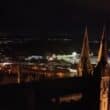
An international collaboration of astronomers led by Armagh Observatory and Planetarium (AOP) has launched a ground-breaking study into the most massive stars in our local dwarf galaxies, the Small and Large Magellanic Clouds.
Led by the organisation’s Professor Jorick Vink, the XShootU consortium collaborated with the Space Telescope Science Institute to undertake the research project.
Published by Astronomy & Astrophysics and titled ‘X-Shooting ULLYSES: Massive Stars at Low Metallicity’, the paper is the first in a series of many by the worldwide collaboration.
It is based on information gathered using unique ultraviolet data gleaned from the Hubble Space Telescope via its UV Legacy Library of Young Stars as Essential Standards (ULLYSES) Legacy project.
This was combined with ground-based optical data observed using the European Southern Observatory’s Very Large Telescope.
During the project, the Hubble Space Telescope underwent 1,000 orbits to observe 250 massive stars as well as young stars under the ULLYSES program.
Professor Hugues Sana of KU Leuven Institute of Astronomy led the reduction of the European Southern Observatory’s data. He said: “With 1000 HST Orbits, ULLYSES is the largest project ever undertaken on the Hubble Space Telescope.”
The study describes how it has become clear over recent decades that metallicity changes the fundamental physical properties of stars, and that in the case of massive stars, stellar winds are driven by metals.
Metals are the chemical elements that make up the Periodic Table, and upon which all life on Earth is based.
Andrea Mehner, Staff Astronomer at European Southern Observatory, commented: “We were delighted to collaborate on this vital research paper and are pleased that our Very Large Telescope has played a key role in observing the effects of metallicity on stars.”
The paper also observes how, from the beginning of the Universe, metal content has grown continuously due to chemical stellar feedback in the form of winds and supernova explosions from massive stars.
It notes that these interactions have helped to create the solar metallicity environment of the Milky Way Galaxy.
Dr. Alex Fullerton, Observatory Scientist at the Space Telescope Science Institute, added: “We are excited to see the many scientific insights that the community will derive from this extensive library of optical and UV spectra.”
‘X-Shooting ULLYSES: Massive Stars at Low Metallicity’ outlines how observations of individual massive stars, along with super-luminous supernovae and other phenomena, indicate that the low-metallicity Universe is fundamentally different from our own Galaxy.
Jorick Vink, Senior Research Astronomer at AOP, commented: “As uncertainties in stellar and wind parameters percolate into many adjacent areas of Astrophysics, the data and modelling used to produce the ‘X-Shooting ULLYSES: Massive Stars at Low Metallicity’ research paper is a game-changer for our physical understanding of massive stars at low Z.”



